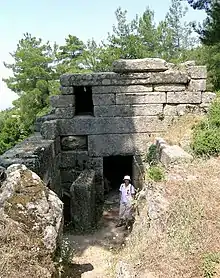Idrieus
Idrieus, or Hidrieos (Ancient Greek: Ἱδριεύς, romanized: Hidrieús; died 344 BC) was a ruler of Caria under the Achaemenid Empire, nominally a Satrap, who enjoyed the status of king or dynast by virtue of the powerful position his predecessors of the House of Hecatomnus (the Hecatomnids) created when they succeeded the assassinated Persian Satrap Tissaphernes in the Carian satrapy.
| Idrieus | |
|---|---|
 Coinage of Idrieus. Obv: Head of Apollo wearing laurel wreath, drapery at neck. Rev: legend ΙΔΡΙΕΩΣ ("IDRIEOS"), Zeus Labraundos standing. Circa 351/0 to 344/3 BCE.[1] | |
| Satrap of Caria | |
| Reign | 351–344 BC, |
| Predecessor | Artemisia II |
| Successor | Ada |
| Consort | Ada |
| House | Hecatomnids |
| Father | Hecatomnus |
| Hecatomnid dynasty (Dynasts of Caria) | ||||||||||||||||
|---|---|---|---|---|---|---|---|---|---|---|---|---|---|---|---|---|
|
||||||||||||||||


Biography
He was the second son of Hecatomnus, and succeeded to the throne on the death of his sister Artemisia II of Caria in 351 BC.
Shortly after his accession he was required by the Persian king, Artaxerxes III Ochus, to provide arms and troops for the capture of Cyprus, a request with which he readily complied. He equipped a fleet of 40 triremes and assembled an army of 8000 mercenary troops. These were despatched for use against Cyprus under the command of Evagoras and the Athenian general Phocion. This is the only recorded event preserved from his reign. However; it can be inferred from Isocrates that by 346 BC[3] the friendly relations between Idrieus and the Persian king had not continued and there appears to have been open hostility between the two.
But the hostility of Persia did not interfere with Caria's prosperity, for in the same passage by Isocrates, Idrieus is described as one of the most wealthy and powerful of the princes of Asia and Demosthenes advises [4] that Idrieus had added the important islands of Chios, Cos, and Rhodes to his hereditary dominions.
That Idrieus was an active builder is attested in Halicarnassus, as it is he who must have finished the Mausoleum, the tomb of his brother Mausolus, begun by their sister, Mausolus' wife, and his own immediate predecessor, Artemisia II, which had been left unfinished at her death; and at Labraunda (alternatively Labranda Ancient Greek: Λάβρανδα), where, continuing the enrichment in the Hellenistic style undertaken there earlier by Mausolus, he restored the temple of Zeus, added the southern and eastern entrances, and built the 'Doric house'.
Idrieus died of a disease in 344 BC, after a reign of seven years, leaving in his will the sovereign power over Caria to his sister Ada, to whom he had been married.[5]
References
- Smith, William (editor); Dictionary of Greek and Roman Biography and Mythology, "Idrieus", Boston, (1867)
Notes
- "Ex von Aulock Collection". Classical Numismatic Group (CNG). 2007.
- Precise date of 341-334 BC according to Meadows CNG: CARIA, Achaemenid Period. Circa 350-334 BC. AR Tetradrachm (15.07 g, 12h). Struck circa 341-334 BC.
- Isocrates, Speeches and Letters, "To Philip", 102
- Demosthenes, Speeches, "On the Peace", 25
- Diodorus Siculus, Bibliotheca, xvi. 42, 45, 69; Strabo, Geography, xiv. 2; Arrian, Anabasis Alexandri, i. 23
External links
![]() This article incorporates text from a publication now in the public domain: Smith, William, ed. (1870). "Idrieus". Dictionary of Greek and Roman Biography and Mythology.
This article incorporates text from a publication now in the public domain: Smith, William, ed. (1870). "Idrieus". Dictionary of Greek and Roman Biography and Mythology.